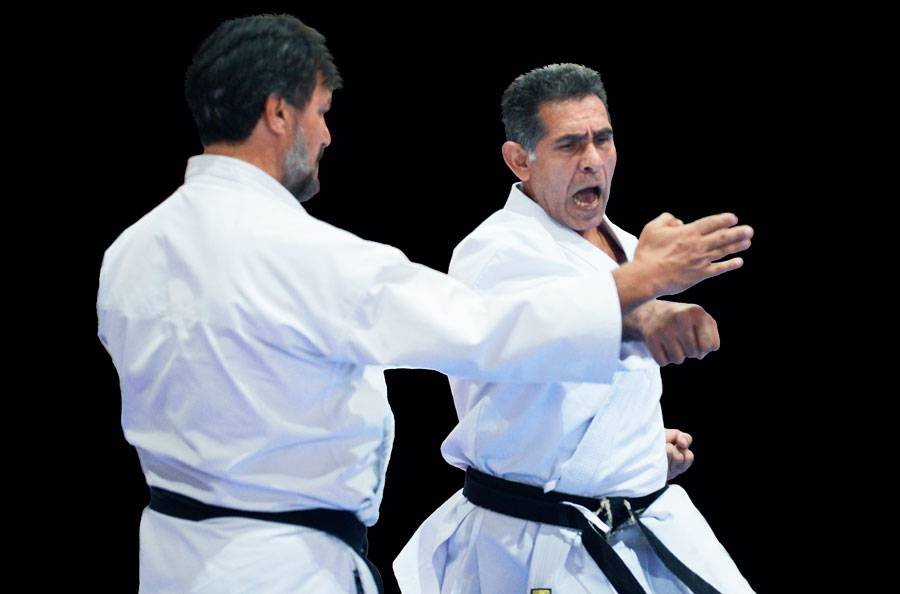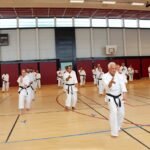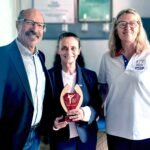Faithful follower of master Hidetaka Nishiyama and one of the greatest karate practitioner of all time, sensei Justo Gómez shows how the practice of karate-do has impacted his life
Interwiev
July 10, 2020
By PAULO PINTO
Photos ISABELA LEMOS / BUDOPRESS and ARCHIVE
Curitiba – PR
Born on April 8, 1966, in Estanislao del Campo, in the Argentine province of Formosa, the son of peasants and of very humble origin, Professor Justo Gómez became one of the greatest champions of the International Traditional Karate Federation (ITKF) and today is the world ambassador of traditional karate-do and a member of the institution’s Technical Committee.
Bearing the title of teacher shihan shichi-dan (7th dan), sensei Gómez is the general director of the Justo Gómez Traditional Shotokan School of Karate, based on four continents and nine countries, as well as a class A international referee in kumite and kata.

Justo Gómez performing the Gojushiho Dai kata in the 2007 Warsaw World Cup final
When, how and why did you start practicing karate?
My parents were humble people; we lived and worked in the field. The rural school where we studied was 9 kilometers from home, so my four brothers and I went horseback riding to it. This farm was located 30 kilometers from the city of Formosa, capital of the province that bears the same name. When I was 9 years old, cultural programs from different countries were being shown on the local television channel, and in one of the videos they showed Japanese culture, which caught my attention a lot. I was inspired to see so many people doing exercises with so much energy, skill, martiality and discipline.
But where does karate come in?
I saw that in Japan karate was practiced by young people in schools, colleges and even by families at home. These images motivated me to practice in the field, making the movements I had seen in the videos. My family tried to get this idea out of my head, but I soon realized that it was impossible to get away from the passion that karate aroused in me. My mother decided to make an effort in the savings and pay me a month of karate lessons so that she could learn and not bother her with this subject anymore. I started practicing on my birthday on April 8, 1975, at 9 years old. What my mother and I didn’t know was that karate practice is lifelong and, at the end of each month, I should pay the fee again. This made my mother give up because it was very difficult to stay within our financial means.

Justo Gómez teaching a course at the ITKF Legends Workshop held in Curitiba in December 2019
And how did they resolve the impasse?
As I could not afford practical karate lessons, I continued training alone in the field, at times when other people in the house did not see me. I had to train in secret because they made fun of my practices. My family did not approve of the passion for karate, I thought that learning karate was a waste of time and I would not be able to survive with this profession as an adult. As I had no money, I proposed to clean the dojo every day before going to school in exchange for karate lessons. Even though I didn’t need anyone to clean the dojo, sensei Alberto Goiris accepted my proposal. Over time, I started helping him with the younger students. I enjoyed helping with classes so much that I also taught karate to my classmates and friends at school. At the age of 15, I was invited to do an exhibition in a very small town, 300 kilometers from Formosa. The organizers were very impressed with my performance and asked to stay in the city and teach karate to young people. The city was called Ibarreta, and I started teaching karate at the age of 15 to over 100 people.

Sensei Hidetaka Nishiyama correcting Justo Gómez’s posture during a course held in Moscow, Russia in 2000
How was your first sensei?
My first sensei was Professor Alberto Goiris, in the province of Formosa. The most important things he taught me were the infinite passion for karate, humility and perseverance, as well as helping me to develop the intuition and perception to learn karate. The Goiris sensei was deaf and dumb. So, I had to develop my perception to understand his teachings.
When did you get the black belt?
I took my sho-dan exam in 1982 with sensei Mitsuo Inoue, JKA representative in Argentina. With Shihan Hidetaka Nishiyama I took the exam for fifth dan. From the sixth to the seventh I took the exam before the ITKF Technical Committee.

Gilberto Gaertner at Justo Gómez in Buenos Aires in January 202
What is your favorite technique?
I don’t really have a favorite technique. I just act according to the situation: I choose to be determined, I keep my mind empty, I connect with my soul with my goal. I respond by intuition, with total determination, so that everything my opponent does can be neutralized in the most efficient and lethal way possible, without leaving the slightest scope for reaction. I call this the heart technique.
What is your favorite kata?
My favorite kata is soochin. On a visit to Master Hidetaka Nishiyama, in California, he asked me which kata he would like to improve. I was impressed with the tremendous honor and asked if I could dive in soochin. He had all the students for a week doing soochin and bunkai. I believe that to learn, understand and master a kata, it must be practiced in all terrains and situations: on sandy and slippery floors, in the mountains. The practitioner should think about applying his techniques in shiai kumite against all types of weapons, different forms of attacks and emotional states.

Senseis Gómez and Nishiyama in the course held in Yugoslavia in 2003
What is the importance of maintaining continuous practice?
Without constant practice, the spirit of karate is lost. It is essential for constant technical development. Without the daily exercise of karate, the concepts of budo became confused and are lost. Continuous practice allows us to be consistent in thinking, saying and doing.
When did you start training directly with Shihan Hidetaka Nishiyama?
I met shihan Hidetaka Nishiyama in 1990 and was very impressed with his knowledge and mastery of karate and the relationship between karate and budo. Since then, I started following him everywhere he taught courses and seminars. After a Summer Camp, in which the sensei taught courses for teachers, I spent several months in the USA training to delve into the finer details of the technique taught by Master Nishiyama. The master always invited me to lunch or dinner, when I asked all kinds of questions related to traditional karate techniques; he wanted to know his views on karate and budo.

Justo Gómez teaching a course at the ITKF Legends Workshop held in Curitiba in December 2019
How did the rapprochement between you happen?
It was at a seminar held in Montevideo, Uruguay. I was honored to be selected by the teacher among hundreds of participants to do kata, and he showed me the technical corrections to the principles of traditional karate. I identified with his teachings and with the deep vision of karate. It was on that occasion that I first heard about budo. Since then, I have changed my views on karate and the way I practice it.
What was his main characteristic as a teacher?
As a karate master, sensei Nishiyama was the person who passed on to our generation the legacy of centuries of ancestral knowledge through the principles of traditional karate. As he said, “budo is a treasure of humanity”. Master Nishiyama’s main characteristic was his relentless pursuit of self-improvement in all areas. This can be easily appreciated in the depth of his technical teachings of the principles of traditional karate and the simplicity of his actions. His techniques were very simple, but sublimely lethal, so that he left no room for other actions or gave the opponent a chance to react.

Sensei Nishiyama hands over fukugô champion trophy to Justo Gómez at the 2007 Warsaw World Cup
And as a person?
As a person, he was a teacher who, with every gesture, word or action, left profound teachings from centuries of knowledge. He wasted no time, he was always teaching. Once, in Russia, during a break from a course in Moscow – I was holding his briefcase, books and notebooks -, as usual I asked him a question: “Why did you distance yourself from competitions and sports issues?” His answer made me very sad, but also aware of the reality of life, its times, the sense of responsibility and true commitment. He told me: “When my university colleagues and I were young, we made the first competition regulation, which said only what techniques could be used and in which areas of the body they could be applied. Referees have always been karate masters and there have never been any disadvantages in interpretation. But people unrelated to karate took the rules and organized competitions to hit and kick without knowing karate. Now, I am very old and I am leaving, I need to repair this damage, but I have no more time ”. Professor Nishiyama had a huge commitment to humanity, he wanted to leave the best version of karate as an educational contribution for the next generations.

Sensei Hidetaka Nishiyama congratulates Gómez for his achievement in Warsaw
What are the main characteristics that a good karate teacher?
Personally, I idealize master Hidetaka Nishiyama as the ultimate expression of the karate teacher. Being a teacher of traditional karate is a challenge and a great commitment to humanity. A high degree of human values must be brought together. Traditional karate practice and precepts must be brought into your own life. Live as you practice, and practice as you live. The teacher’s influence on students is inevitable, which is why ongoing training and constant self-criticism are very important. Sensei Nishiyama was always looking to improve. Once, returning from one of the morning practices, I told him about the subject that the class had developed. He asked me if I understood, and I said yes. Then, he replied smiling: “I am always practicing and trying to improve so that students have a better understanding of the concepts I passed on to you”. He was always practicing, even when he taught us that he was focused and in constant learning. Obviously, what he taught us was something really brilliant from all points of view.

Professor Justo Gómez is also a member of the Technical Committee of the International Traditional Karate Federation (ITKF)
Until Nishiyama’s death, the traditional walked in a block and cohesively. Why didn’t sensei Hidetaka prepare the organization for a new era?
The sensei prepared us to be great teachers and to pass on his legacy to humanity. Master Nishiyama received the same legacy from his teacher, sensei Gichin Funakoshi. Mestre Nishiyama left the ITKF very well structured, the most qualified technical committee in the organization, and even today this group of the oldest is managed by their technical qualifications. Sensei Nishiyama prepared the entire ITKF organization through his techniques to continue to transmit the principles of traditional karate to subsequent generations. Unfortunately, some leaders changed direction.
How do you rate the current ITKF moment?
ITKF is a highly recognized international organization and this is the best moment for it because we plan goals and, of course, we are all affiliated members working with all our strength and enthusiasm in the same direction. We are currently close to 50 member countries and we will soon have many more. In addition, its excellent board of directors respects and promotes the members and their employees. We expect that, by the end of this year, the organization will bring together more than 70 countries.

Justo Gómez in the final of the Treviso World Championship in Italy in 1994, when he was runner-up in the world of individual kata
Do you believe that ITKF will return to what it was in the past?
As I said, we hope to double the number of members soon. Entities that have left the ranks of traditional karate to join the sport are gradually returning. They never wanted to leave the sport, they just hoped that the sport would become Olympic. As it did not, they naturally return to the sources of traditional karate. Everyone is always very welcome and we are here to help them grow and to strengthen the organizations of each country in search of great traditional karate, united and focused on the true path of budo.
“The evolution comes from the acceptance of these individual differences to achieve a greater purpose than ourselves.”
What is pressing for the ITKF today?
Currently, ITKF prioritizes the training of its technicians and referees, as well as that of national representatives, to improve the transmission of ITKF’s global objectives. But these goals are not just technical, they are organizational, institutional and political. In the competitive area, we plan to create greater competitive bodies to further increase the technical level of our athletes.

Sensei Nishiyama teaching a course for teachers in San Diego, California
Some fighting modalities hold eight world championships a year, in addition to events with cash prizes. ITKF maintains the format created by Nishiyama in the 1970s. Do you believe that this model will last for a long time?
We have several international competitions, in addition to the traditional ones, such as the World Cup and the regional championships by continent, which started this year and which, unfortunately, were interrupted by the covid-19 pandemic. ITKF plans to expand the number of competitions.
How do you rate the Curitiba World Cup 2019?
The technical level observed during the last ITKF World Cup was very good, and we can continue to improve. We have very talented and dedicated practitioners on every continent. We have a team of excellent referees and judges who have worked in a coordinated and efficient manner throughout the World Cup. The excellent prior training of the referees by the technical committee was essential to achieve a clean and clear competition in all shiai-jô. Speaking of organization, it was an event equal to the best of the First World. It was this, in fact, that most excited the members who are returning to the ranks of the ITKF.

Gilberto Gaertner, president of ITKF visits the Traditional Shotokan Karate School Justo Gómez
You were one of four teachers who taught courses at the ITKF Legends Workshop, parallel to the world one. How do you evaluate them?
I think it was a great experience for young athletes to be able to observe and listen to older competitors who, in one way or another, marked an era in competitive history. Personally, I think it is an excellent idea for the new management because it brings together and unites several generations of athletes. Former athletes can inspire and help young people to move faster towards competitive evolution and achieve technical excellence in less time. Some of the great ITKF world champions and personal friends still remain in other organizations, and my dream as an ITKF ambassador is to reunite them at the ITKF, bringing out the best in everyone. There will always be different opinions, and they are important. Evolution comes from accepting these individual differences to achieve a purpose greater than ourselves. The division hurts everyone.
ITKF has a broader view on karate, focusing on socio-educational actions and recognizing its enormous therapeutic appeal. How do you evaluate karate beyond the competitive landscape?
Traditional karate includes in its daily practices activities that take students to very deep places of their being, directly impacting the emotional, spiritual and mental aspects. This naturally leads to an understanding of themselves that allows them to voluntarily assume the direction of their lives. With constant and serious practice, it is possible to observe positive and significant changes in the students’ personality, regardless of age and physical or sociocultural condition. For this reason, traditional karate focuses its main objective on the human aspect of the practitioners, casting a vision far above the competitive field. Traditional karate is a very powerful educational tool, not only for physical but also emotional development, positively affecting all social aspects.

Justo Gómez teaching a course at the ITKF Legends Workshop held in Curitiba in December 2019
Does the current ITKF board have the necessary credibility to regroup the traditional world?
Undoubtedly. The current executive council was elected by acclamation at the 2019 meeting, and I understand that our leaderships have a very broad, current and flexible view. We are a large organization with ambitious goals. From the beginning, the current management is bearing fruit, so much so that immediately after the World Cup new members joined the ITKF and the planned projects are being carried out in a timely manner, despite the pandemic. The measures taken by this administration have been very positive for the current members and for everyone who will join us in the future.
In your assessment, what was the impact of this pandemic on the current ITKF structure?
Covid-19 made us keep in constant contact with the organization’s members and affiliates. Taking advantage of the fact that we are all in quarantine, we created free online arbitration and technical training activities for all members. There are also national and international online competitions offered permanently by ITKF to its members in different continents and member countries. Incredibly, the pandemic favored our structure for more fluid and permanent communication between the different work committees that make up the ITKF. The goal is to take advantage of all the instances that life offers us to learn, grow and become stronger and stronger. The legacy of our ancestors must prevail as a guide for improving ourselves and passing on this knowledge to future generations. The tradition continues!

Justo Gómez, Gilberto Gaertner and Luiz Vazquez in Buenos Aires
What is the biggest contribution that karate-do offers to society?
I believe that the most important contribution is an awareness of the value of life. The practice of karate-do increases awareness and awareness of the world in which we live. In karate we call this Zanshin, a state of alert focused on the here and now. Zanshin’s state allows us to control our reactions and those of our opponents. The continuous and constant practice of this state leads us to have an efficient and determined attitude in dangerous situations, constantly seeking to use all internal and external human qualities: mind, spirit and body simultaneously, which multiplies our potential. Finally, the daily practice of this state ends up opening doors of awareness, connection and control of the context, which guarantees us to enjoy a more conscious and full life. This allows us to be better in any field in which we develop in family or professional life.

Teachers Justo Gómez and Hidetaka Nishiyama at the World Budo Congress in Krakow, Poland in 2007
Main Titles of Justo Gómez
ITKF World Champion in Canada, individual kumite, 1992
ITKF World Champion in Treviso (Italy), fukugô, 1994
ITKF World Champion in Ferrara (Italy), individual kumite, 2001
ITKF World Champion in Saskatoon (CAN), individual kumite, 2006
Champion of the World Cup in Milan (Italy), kumite, 1991
Champion of the World Cup in Moscow (Russia), fukugô, 2000
Champion of the World Cup in Moscow (Russia), kumite team, 2000
Champion of the World Cup in Warsaw (Poland), fukugô, 2007
Bronze at the ITKF World Cup in Lima (Peru), kata team, 1990
Bronze at the World Cup in Milan (Italy), kata, 1991
ITKF Mexico Pan American Champion, individual kumite, 1991
ITKF Mexico Pan American Champion, individual kata, 1991
Pan American champion of ITKF Mexico, kata teams, 1991
Pan American champion of ITKF Mexico, kumite teams, 1991
Runner-up in the ITKF Canada, kumite team, 1992
Bronze at the ITKF Canada World Championship, individual kata, 1992
Pan American ITKF champion Puerto Rico, individual kumite, 1993
Pan American ITKF champion Puerto Rico, individual kata, 1993
Bronze medal at the ITKF Puerto Rico Pan American, kumite teams, 1993
ITKF runner-up in Treviso (Italy), kumite, 1994
ITKF runner-up in Treviso (Italy), kata, 1994
Pan American ITKF champion in Argentina, kumite team, 1995
Pan American ITKF champion in Argentina, individual kumite, 1995
Pan American ITKF champion in Argentina, fukugô, 1995
Pan American ITKF champion in Argentina, individual kata, 1995
Bronze at the ITKF World Championship São Paulo (Brazil), fukugô, 1996
Bronze at ITKF World Championship São Paulo (Brazil), individual kata, 1996
Bronze at the ITKF World Championship in Ferrara (Italy), fukugô, 2001
Warsaw World Cup runner-up (POL), individual kumite, 2002





